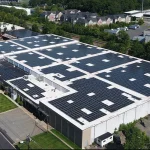However, it is hard to think of an urban area that is more convenient than a parking lot. Not only are they unpleasant to the eye, they are usually quite large, so they are very likely to generate energy.
According to a 2021 study co-authored by Pierce, just installing solar panels in the parking lots of 3,751 Walmart Supercenters across the country could produce as much electricity as about 10 coal-fired power plants. can be generated. (Even considering the part-time nature of solar power, covering these Walmart lots could permanently shut down two, perhaps even three, such plants in sunny areas, Pierce said.) I think.) In France, the government says the sun canopy is equivalent to 11 gigawatts of renewable energy, or the power of 10 nuclear reactors. This corresponds to about 8% of the country’s electricity production.
Installing a solar canopy could also help drivers. It provides shade in sunny and warm weather, can reduce the need for air conditioning when people hop in their cars, and protects them from rain and snow in winter. If the vehicles parked under it are electric, the generated energy can also be fed directly to these vehicles. Most commuters now charge their electric vehicles at home outside of normal work hours. The freedom to charge while shopping or at work can potentially avoid peak prices.
You can even balance the grid by connecting your parked EV to a solar canopy. Since the traditional grid has no energy storage capacity, the power supplied must match the power consumed, and too much power in the grid becomes a problem. For photovoltaics, production has to stop, especially during peak sunshine hours. However, if surplus energy can be stored in on-site EV batteries, the full potential of solar power can be exploited during peak production times.
“During the day, EVs can store energy,” says Nathanson of parked EVs. “Electricity can be put back on the grid around evening, when electricity consumption peaks.” So many independent devices will be used in conjunction with the grid to ensure that no one is starved for energy. requires a fair amount of smart automation. It also requires a two-way charging device, which is not widely used at the moment. But it could be smarter with solar.
However, not all parking lots turn into power plants. There is sometimes too much shade, probably due to the tall buildings nearby. Long shadows are more of a problem, especially in winter, in northern countries where the sun is low on the horizon. In other lots, the panels can reflect sunlight onto nearby buildings or, worse, roads, warns Dylan Ryan, a lecturer in mechanical and energy engineering at his Napier University in Edinburgh, Scotland. doing. “Are you going to let the sun shine in the eyes of the people working across the street?”
The biggest concern, however, is cost. Installing solar panels over parking spaces is several times more expensive than installing them on the ground or on rooftops, as you need to build a support structure. (These costs are likely to be higher in the UK than in Southern Europe, because there are still no shades for UK car parks.) Without subsidies, too many operators are a must. Pearce says it’s hard to imagine installing a solar canopy that isn’t.
Of course, parking operators can recoup their upfront investment by charging customers to plug in their EVs. Alternatively, you can use the electricity yourself for whatever business the parking lot provides. Alternatively, the power can be sold to the grid. “Whether you’re just selling electricity to the grid or just using electricity for your business, your overall electricity bill will be lower,” he says.
This is not to say that solar farms belong only to urban areas. However, there are clear advantages to generating more solar energy closer to where people are, and it is clear that we need to find ways to do this without stumbling upon nimvism. You can avoid this problem by using a car park. For these reasons, French law, though aggressive, is a big step in the right direction. “You’re essentially taking advantage of free real estate,” says Ryan.










